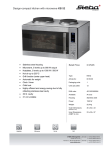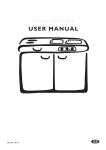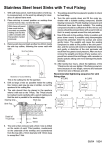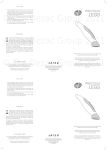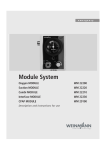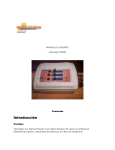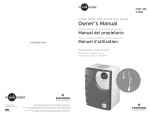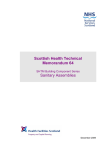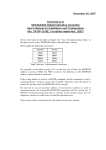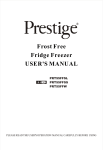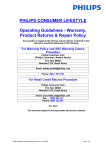Download Using your appliance - John Strand MK Ltd.
Transcript
Contents Information for the user Unpacking the product 3 - If the product is damaged - When lifting the Compactkitchen - Identification of materials - Levelling Safety information 4-5 Description of the appliance 6 Using your appliance 7 - Refrigerator - Hotplates - Timer Care and maintenance 8 - Defrosting - Cleaning the refrigerator - Replacing the bulb inside the refrigerator - If the refrigerator is to be left unused - If the hotplates are to be left unused If Compactkitchen is not working 9 Service and Guarantee 9 - Service and spare parts - Guarantee Information for the installer Installation 10 - Application and environment - Installation - Choice of site Technical data 11 -2- Unpacking the product If the product is damaged If the product has been damaged during transportation, you should immediately notify the company responsible for delivering it. Check the Compactkitchen carefully for any damage. If you discover any damage, defects or that anything is missing, you should notify the seller immediately. Never leave packaging material in a place where children may play with it. When lifting the Compactkitchen Take care when lifting the Compactkitchen. Incorrect methods of lifting can cause physical injuries and also increase the risk of damage to the product. Identification of materials All materials used in packaging this product are environmentally-friendly. The various plastics used are identified and can be recycled: • PE stands for polyethylene, used, for example, for the bag the instruction book is packed in. • PS stands for polystyrene (in this case moulded polystyrene), which is used for the sections of packaging needed to cushion the product in transit. The product packaging is made from recyclable materials and should be taken to a recycling centre. The Compactkitchen contains plastic and rubber components. These have identifying marks to show what they are made from, so they can be recycled or disposed of properly at the end of the product's service life. The materials are identified according to international standards. Levelling The Compactkitchen must be installed on a firm, stable surface and levelled. Use a spirit level and adjust the level with the aid of the three adjustable front feet. -3- Safety information Before you install and start to use the Compactkitchen, read through the instruction book carefully, including its hints and warnings. This helps ensure you get the best possible performance from the product. Anyone using the Compactkitchen should be thoroughly familiar with its instructions for use and safety features. Save these instructions and make sure they remain with the Compactkitchen if it is moved or sold, so any subsequent owners will be able to read about its functions and safe use. ❐ Make sure that children will not under any circumstances touch the hotplates or cooking utensils on them when hot. Turn all pan handles inwards to reduce the risk of young children pulling pans over. Remember that the hotplates can remain very hot for a long time after they are switched off. ❐ All packaging must be removed before the product is first used. Failure to do this could result in damage to the product or other property. ❐ Do not place in the freezer compartment any bottles of liquid which would expand when frozen and cause the bottle to shatter. ❐ All installation work and repairs or other work on the product must be carried out by a qualified tradesman. Work performed by persons with inadequate knowledge may adversely affect the satisfactory functioning of the product and may cause personal injury or damage. ❐ In the event of a power cut, avoid opening the refrigerator door. If the freezer compartment is completely full, frozen foods in it will not be affected by a short power cut (3–4 hours). If frozen foods have started to defrost, however, it is advisable to use them as soon as possible. ❐ The Compactkitchen is heavy, so take care when moving it. See "Unpacking the product". ❐ When defrosting the refrigerator, do not use candles, hairdryers or fan heaters. If you use a saucepan of hot water for defrosting, do not let it touch the plastic walls or rest on the bottom of the refrigerator. Any frozen foods removed temporarily from the freezer compartment should be kept in a well-insulated container to keep them as cold as possible. Remember that the storage life of frozen foods will be reduced if they are not kept cold enough when you are defrosting the refrigerator. ❐ Make sure that the Compactkitchen is not left resting on any electrical leads. ❐ The Compactkitchen is designed only for normal domestic use and in accordance with these instructions. If it is used for other purposes, there is a risk that this may cause personal injury or damage to property. ❐ Never store flammable substances (such as methylated spirits, lighter fluid, white spirit) in the Compactkitchen storage cupboard. ❐ The Compactkitchen is to be installed indoors, in an ambient temperature which should be between 10°C and 32°C. It should preferably not be installed in a busy hallway or corridor. ❐ Never use knives or other sharp objects to remove ice when defrosting, as these could easily damage the refrigeration coils. ❐ The Compactkitchen should be used by adults or under adult supervision only. Never allow children to play with the hotplate controls or to touch any other controls. ❐ ADVICE: Frozen foods should not be kept for longer than the time indicated on the packaging for storage at -12°C. If frozen foods have thawed, they should not be frozen again but used as soon as possible. -4- Safety information ❐ Never stand on the sinktop. ❐ Deep-frying has the potential to cause fires. Never leave the Compactkitchen unattended while deep-frying foods. If fat catches fire, smother the flames by covering them with a pan lid. Never use water. If you have a cooker hood or extractor fan, switch the fan off at once. ❐ Never leave any combustible objects on the hotplates, even if you never use the hotplates. Electrical appliances and leads must always be kept well clear of the hotplates. ❐ Always check that the hotplates are switched off after use. ❐ If the refrigerator is not used, its door should be left ajar. This keeps its door seal in good condition besides preventing any unpleasant odours or moulds from arising inside it. ❐ Before any repairs or maintenance are carried out, make sure the Compactkitchen is isolated from the electrical supply by unplugging it from the electrical sockets. ❐ Servicing and repairs may only be carried out by a service company approved by the supplier. Use only spare parts supplied by these. Never try to repair the product yourself. ❐ At the end of the Compactkitchen's useful life, disconnect the electrical plugs from the power supply, then cut off the electrical leads at the point where they enter the product. Cut-off plugs and leads must be immediately destroyed or disposed of safely so that there is no chance that children will ever play with them. Remove the refrigerator door to remove the risk of children later playing inside it and possibly suffocating. -5- Description of the appliance 10 11 12 13 14 1 2 3 4 5 15 16 6 7 17 18 8 9 Logotype MADE IN SWEDEN TYPE. MOD. PROD. NO. SER. NO. 230 V~ 50 Hz 2200 W 13AA 10 1 Stainless steel sinktop 11 Hotplates 2 Sink 12 Hotplate controls 3 Indicator light 13 Freezer compartment 4 Waste water connection 14 Thermostat control 5 Storage cupboard 15 6 Cupboard door Refrigerator section with storage shelves 7 Vegetable drawer 16 Door compartment 8 Adjustable feet 17 Refrigerator door 9 Door handles 18 Seal 10 Timer control -6- Using your appliance Refrigerator Initially turn the thermostat control to a setting somewhere in the middle (3–4), then adjust if necessary after a day or so to maintain a temperature of approx. +5°C. The higher the number, the lower the temperature inside the refrigerator. The defrosting tray below the freezer compartment is also used to regulate the temperature distribution between refrigerator and freezer compartment. If the tray is lifted and slid towards the rear wall, this will lower the temperature inside the freezer compartment and raise the temperature in the refrigerator section. If you keep frozen foods in the freezer compartment, the defrosting tray should be left in its rear position. How to use the timer function All Compactkitchens with hotplates also have a built-in timer function. The hotplates will not start to heat until the timer has been started. The timer cannot be set for longer than 60 minutes. If you need the hotplate for longer than 60 minutes you simply restart the timer. The timer is useful if you wish to set the hotplate to switch off automatically after a certain cooking time. After you have set the timer, switch the hotplate control to the required setting (6 is hottest). The hotplate indicator light will come on. When the time set has elapsed, the timer will switch off the hotplate and the indicator light will go out. Remember to turn the hotplate control back to off (0) when you have finished using any hotplate. -7- 6 5 0 4 6 5 4 0 15 The hotplate controls on the edge of the sinktop have seven settings: six temperature settings and off (0). The hotplate indicator light comes on when either of the hotplates is switched on. The hotplates have had an anti-corrosion product applied in the factory. This will provide more effective protection if you heat the hotplates without pans the first time, when the Compactkitchen is brand-new. Before using the Mini Kitchen for the very first time, switch on both hotplates (use setting 4) and leave them on for 10 minutes. Then let them cool completely before they are used for cooking. Make sure that all pans used on the hotplates have perfectly flat bases, as these are the most efficient in conducting heat. To save both energy and time, try wherever possible to use a pan with a base of the same diameter as the hotplate. 0 Hotplates (some product versions) Care and maintenance Defrosting A build-up of ice on the refrigeration coils cannot be avoided. This ice arises because the moisture from air entering the refrigerator condenses on the refrigeration coils and freezes. To minimise it, avoid opening the freezer compartment unless you need to, and do not leave the refrigerator door open for longer than necessary. You should defrost the refrigerator when the layer of ice is about 5–10 mm thick, as follows: ■ Take the frozen food out of the freezer compartment, pack it (for example) in newspaper to keep it insulated, then put it in a cool place. ■ Put a bowl on the top shelf beneath the hole in the defrosting tray, to catch the water as it melts. ■ Switch off the refrigerator by turning its thermostat control to the left, to the off position (black dot). Replacing the bulb inside the refrigerator The bulb is located on the rear of the thermostat housing, on the right inside the refrigerator. To replace it: ■ Isolate the refrigerator from the electrical supply by disconnecting the plug from the socket. ■ Take out the defrosting tray from under the freezer compartment. ■ Take hold of the bulb by inserting your fingers from the rear, behind the bulb cover. Unscrew the bulb by turning it anticlockwise. ■ The bulb should be marked 230 V 10 W and have an E 14 cap. If the refrigerator is to be left unused: ■ When you have finished defrosting turn the thermostat control back to the required temperature. ■ Isolate the refrigerator from the electrical supply by disconnecting the plug from the socket. ■ When the refrigerator has started working again the bowl of water can be removed and the frozen food can be put back in the freezer compartment. Cleaning the refrigerator Isolate the refrigerator from the electrical supply by disconnecting the plug from the socket. Remove all the food and put it somewhere cool. Clean the interior and exterior of the refrigerator using water and a suitable mild, unperfumed cleaning product. Close the door, plug in and switch on the electricity. The food can be put back after 10–20 minutes. The hotplates, sinktop and other parts can also be cleaned using warm water and a mild cleaning product. ■ Empty the refrigerator. ■ Clean it as described under "Cleaning the refrigerator". ■ Leave the refrigerator door ajar to prevent any unpleasant odour. If the hotplates are to be left unused: ■ Clean the hotplates thoroughly. ■ Apply to the hotplates either acid-free petroleum jelly or a proprietary product for maintaining hotplates. If you used petroleum jelly, before using the hotplates for cooking again you should first heat them without pans for 5 minutes on setting 3. If you used a proprietary product for hotplates, follow the instructions supplied with that. -8- If Compactkitchen is not working ❏ CHECK: ■ PROBLEM ■ The hotplates will not heat. ❏ Is the Compactkitchen plugged in and switched on? ❏ Has a fuse blown or a circuit breaker tripped? ❏ Have you switched on both the hotplate control and the timer control correctly? ■ The refrigerator is not working properly. ❏ Is the thermostat control on a suitable setting? ❏ Has the refrigerator door been fully closed? ❏ Does the freezer compartment need defrosting? If you have made all the relevant checks above but your Compactkitchen is still not working properly, you should call a service engineer. Service Service and spare parts Guarantee If a problem arises, first work through the check-list "If your Compactkitchen is not working" to make sure that the cause is not something which you can put right yourself. If the solution to the problem is one of the points in this check-list, you may be charged for the cost of the call-out. The same applies to faults caused by use of the Compactkitchen for purposes other than those for which it was intended. Service and spare parts for your Compactkitchen can be obtained from your dealer. You should quote the model and product number on the product's data plate. You can note these details here: 1 year from the invoice date (keep the invoice). The guarantee covers defects in workmanship and materials occuring while being used for domestic purposes in the U.K. The guarantee covers materials, transport and wages. TYPE: .................................................................... MODEL: ................................................................ PRODUCT NO.: .................................................... SERIAL NO.: ........................................................ Date of purchase .................................................. -9- Installation Application and environment The Compactkitchen is designed for normal domestic use. It is to be installed indoors, with an ambient temperture range of 10°C to 32°C. Installation The Compactkitchen is supplied with two electrical leads with earthed plugs, for hotplates and refrigerator respectively, for connection to a single-phase, 230-240 V, 13 A power supply. Maximum wattage is 2300 W. Connection of the Compactkitchen to the water supply and domestic waste systems should be carried out by a qualified plumber. The outer diameter of the waste pipe connector is 50 mm. Recommended rekommenderat områdeof location för electrical eluttag sockets Important points to note on installation It must be possible to pull the Compactkitchen out from the wall for any service or repair work. You should therefore avoid fitting any details such as tiles resting on the Compactkitchen which will make it difficult to move later. The electrical sockets need to be easily accessible, as illustrated. Choice of site The Compactkitchen should not be sited in a hallway or corridor, or any place with many passers-by. The Compactkitchen should not be sited so its refrigerator side is close to a heat source such as a radiator, nor should it be in direct sunlight. It needs a stable surface for its six feet. The minimum distance allowed between the hotplates and any cupboard above them made from combustible materials is 45 cm. - 10 - Technical data DIMENSIONS WEIGHT Height 900 mm Width 1000 mm Depth 600 mm (net) 50 kg REFRIGERATOR 140 L** wattage 100 – 110 W HOTPLATES Ø 145 wattage 1000 W Ø 180 wattage 1200 W Voltage etc. 230-240 V / 50 Hz / 13 A Total wattage incl. refrigerator 2300 W ELECTRICAL DATA – – This appliance complies with the requirements of the following EU directives: 73/23/EEC, dated 19.02.1973 – low-voltage directive. 89/336/EEC, dated 03.05.1989 (incl. amendment 92/31/EEC) – directive on electromagnetic compatibility. - 11 -












